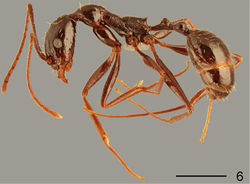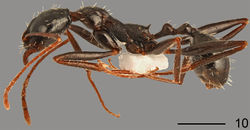Key to Mediterranean Aphaenogaster cecconii group species
This worker key is based on: Borowiec, L., Salata, S. 2014. Review of Mediterranean members of the Aphaenogaster cecconii group (Hymenoptera: Formicidae), with description of four new species. Zootaxa 3861, 40-60. and Salata, S. and L. Borowiec. 2016. A new species of the Aphaenogaster cecconii group (Hymenoptera: Formicidae) from Rhodes. Zootaxa. 4170:194-200.
and
The A. cecconii group is defined by workers with the following characters:
- body surface with indistinct microsculpture, shiny across extensive areas
- body coloration from yellow to black
- head oval and with a sharp basal carina or head strongly narrowed posteriorly to a neck with a flared collar
- antennal scapes elongate, reaching beyond the posterior margin of the head by at least 1/3 their length
- basal and mid antennal segments distinctly longer than wide
- mesosoma narrow and elongate
You may also be interested in
1
- Head strongly narrowed posteriad, with a narrow neck margined by a high and sharp collar . . . . . 2
- Head elongately oval, gradually narrowed posteriad, without narrow neck, with occiput margined by a low, sharp carina . . . . . 4
2
return to couplet #1
- Head and thorax black, brown or partly reddish brown . . . . . 2
- Head and thorax uniformly yellow. Egypt, Jordan and Israel . . . . . Aphaenogaster phillipsi
3
return to couplet #2
- Sides of frons with distinct microreticulation and longitudinal rugae. Head and thorax black or dark brown, first abdominal tergite dark brown to black, at base with large whitish or grey patch. Crete . . . . . Aphaenogaster cecconii
- Sides of frons with diffused microreticulation and at most with rudiments of rugae. Head and thorax brown or yellowish brown, first abdominal tergite uniformly brown. SW Turkey . . . . . Aphaenogaster lykiaensis
4
return to couplet #1
- Head rusty-yellow, frons with brownish triangular patch of diffused borders, thorax, antennae and legs rusty-yellow. SW Turkey . . . . . Aphaenogaster equestris
- Head, thorax, antennae and legs brown to almost black or head, thorax and abdomen pale brown and legs uniformly yellowish to yellowish-brown. Dodecanese . . . . . 5
5
return to couplet #4
- Body pale brown, legs uniformly yellowish to yellowish-brown, paler than thorax. Top of pronotum distinctly microreticulate. PI1>200 and SL>1.8 . . . . . Aphaenogaster charesi
- Body darker, from brown to dark brown, legs and thorax unicoloured. Top of pro-notum with diffused microreticulation. PI1<200 (if bigger then SL<1.8), SL<1.8 (if bigger then PI1<200) . . . . . 6
6
return to couplet #5
- Scape shorter (SL: 1.457–1.763, mean 1.686 ± 0.085), head less narrowed posteriorly (HW/NW 1.869–2.119 mean 1.977 ± 0.074). Surface of head with less distinct microsculpture, especially anterior to eyes and around antennal scrobes; occipital part of head with micoreticulation absent or rudimentary. Base of first abdominal tergite with-out longitudinal grooves or they are very short, without distinct microreticulation between grooves. Body color pale brown. Rhodes . . . . . Aphaenogaster jolantae
- Scape longer (SL: 1.672–1.880, mean 1.752 ± 0.049), head more distinctly narrowed posteriorly (HW/NW 2.132–2.436, mean 2.289 ± 0.082). Surface of head with more distinct microsculpture, especially micoreticulation is well developed anterior to eyes, around antennal scrobes and on occipital part of head. Base of first abdominal tergite with long longitudinal grooves and distinct microreticulation between grooves. Body color dark brown. Karpathos . . . . . Aphaenogaster olympica













